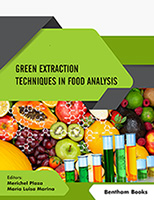Preface
With world-wide concern for environmental issues, there is a growing opportunity for the utilisation of supercritical fluid (SCF) technologies as green alternatives to conventional processes currently used in the pharmaceutical, cosmetic and food industries.
The application of supercritical fluids as an alternative to conventional precipitation and extraction processes has been an active field of research and innovation during the past decades. The main motivation for this has been the possibility of exploiting the peculiar properties of supercritical fluids, which are often described as intermediate between those of a liquid and a gas, easily changeable with small modifications in operating conditions, namely pressure and temperature. In the case of carbon dioxide (the most used supercritical solvent), the supercritical region can be achieved at moderate conditions of pressure and tempreature, avoiding the degradation of thermolabile substances and providing simultaneously an inert medium suitable for processing easily oxidable compounds. Moreover, the use of the supercritical fluid eliminates or reduces the use of toxic or contaminant organic solvents and the elimination of the supercritical fluid from the final product can be easily accomplished by a simple depressurization.
It has become evident that the identification synthesis or isolation of active components is not sufficient to ensure progress in drug therapy. Considerable effort has been devoted to the development of novel approaches for the delivery and administration of organic active agents. Particle and delivery systems design are major developments of supercritical fluids applications. Because of their high diffusivity, high solvent power and low viscosity, SCFs can be used as solvents or antisolvents to micronize bioactive compounds and bioerodible polymers, and impregnate or encapsulate drugs in biocompatible matrices (natural or synthetic polymers, waxes and fats). The continuous formation of solids following the rapid expansion of a highly compressible supercritical solution is an interesting alternative to conventional crystallization methods used in the pharmaceutical industry (spray-drying, jet milling and grinding). Through the rapid expansion process, a dramatic change of the solute supersaturation is created causing subsequente precipitation of small particles with a narrow size distribution. Also the possibility of using supercritical fluid technology for the formation of composite micro/nano-spheres/capsules and impregnation of different polymers has been explored by various researchers for a number of years now.
Supercritical fluid extraction (SFE) has being explored for production of ever-widening ranges of concentrated natural extracts, with positive physiological activity. In fact, the concern on health care created a major opportunity market for natural products with specific health effects and there has been considerable interest in the last decade in switching from synthetic to natural substances in the food and pharmaceutical industries.
This book aims to contribute to disseminate knowledge related with the application of supercritical fluid technology in the development of “clean” separation processes and preparation of delivery devices, with applications in the pharmaceutical and other emergent industries (such as the nutraceutical and cosmeceutical).
We would like to express our gratitude to the authors of each chapter, without whom this publication wouldn’t be possible.
Ana Rita C. Duarte
Catarina M. M. Duarte





